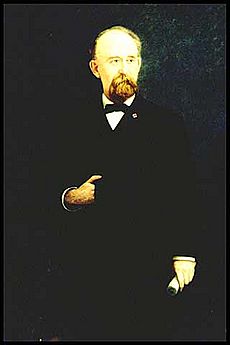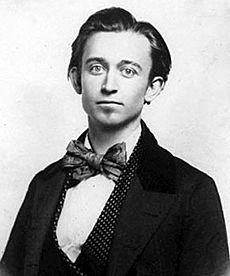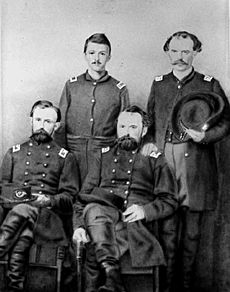Lucius Frederick Hubbard facts for kids
Quick facts for kids
Lucius Frederick Hubbard
|
|
|---|---|
 |
|
| 9th Governor of Minnesota | |
| In office January 10, 1882 – January 5, 1887 |
|
| Lieutenant | Charles A. Gilman |
| Preceded by | John S. Pillsbury |
| Succeeded by | Andrew Ryan McGill |
| Personal details | |
| Born | January 26, 1836 Troy, New York |
| Died | February 5, 1913 (aged 77) Minneapolis, Minnesota |
| Political party | Republican |
| Spouse | Amelia Thomas |
| Profession | newspaper owner |
Lucius Frederick Hubbard (January 26, 1836–February 5, 1913) was an important American politician. He was a member of the Republican Party. Hubbard served as the ninth Governor of Minnesota from January 10, 1882, to January 5, 1887. He also fought as an officer in the Union Army during the American Civil War.
Contents
Early Life and Newspaper Days
Lucius Frederick Hubbard was born in 1836 in Troy, New York. When he was just ten years old, he became an orphan. He started working as a tinsmith in the eastern United States and later in Chicago.
When he was 21, Hubbard moved to Red Wing, Minnesota. He brought an old printing press and some type with him. In only two months, he became the publisher and editor of the Red Wing Republican newspaper. He used the newspaper to share his strong political ideas.
A Soldier in the Civil War
When the American Civil War began, Hubbard joined the Union Army in 1861. He started as a private in the 5th Minnesota Volunteer Infantry.
He fought in several important battles, including the siege of Corinth, the siege of Vicksburg, and the battle of Nashville. He also took part in the Battle of Fort Blakely. Hubbard became the colonel, or leader, of his regiment. Because of his brave service at Nashville, he was made a brevet brigadier general on December 16, 1864. This was a special honor for his military achievements.
From Soldier to Governor
After the war ended, Hubbard went back to Red Wing, Minnesota. There, he worked in milling (making flour) and railroading at the same time. He was elected to the Minnesota State Senate, which is part of the state's government. He served two terms, finishing in 1875.
Hubbard was also a partner in the Midland Railroad. He led the operations of the Cannon Valley Railroad until he was elected governor in 1881.
What He Did as Governor
As governor, Hubbard strongly believed the government should help in many areas. He pushed for government involvement in public health, corrections (prisons), charities, railroads, agriculture (farming), and commerce (business). The state legislature, which makes laws, agreed with him. They increased the state's power to regulate and license different activities.
His second term as governor lasted three years. This was because of a change to the state's constitution. The change made state, county, and federal elections happen at the same time every two years.
Later Years and Recognition
After leaving office in 1887, Hubbard took over another railroad company. In 1898, when America went to war against Spain, President William McKinley appointed Hubbard as a brigadier general of volunteers. Even at 62 years old, he was asked to oversee a military post in Florida.
Two years later, Hubbard moved to St. Paul and then to Minneapolis. He passed away in Minneapolis at the age of 77.
Hubbard County, Minnesota, is named after him to honor his service and contributions to the state.



